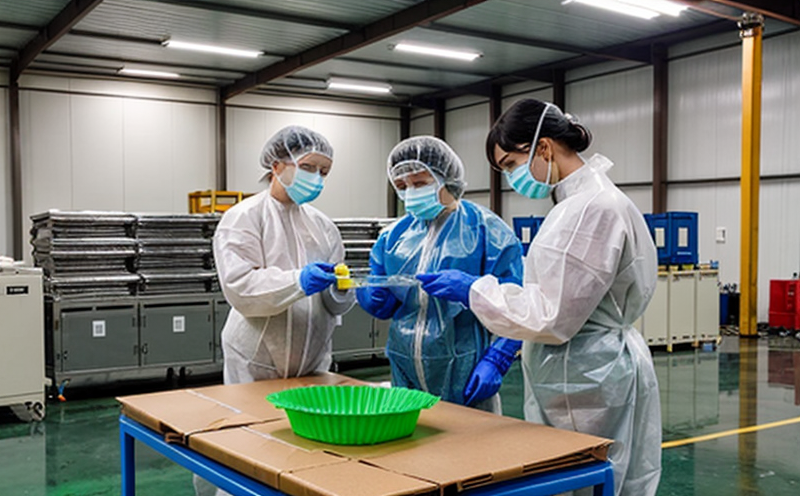ISO 178 Flexural Properties of Plastics Testing
The ISO 178 standard pertains to the determination of flexural properties of plastics. This test is crucial in evaluating how a plastic sample will behave under bending stress, which is essential for ensuring that packaging materials are robust and capable of withstanding real-world conditions without cracking or breaking.
Flexural strength (or modulus) is a key mechanical property that indicates the ability of a material to resist deformation when subjected to an applied load. This test is particularly important in the packaging sector, where plastic containers, trays, and films are exposed to various stresses during manufacturing, storage, handling, and use.
The testing procedure involves applying a defined bending moment to a specimen until it yields or breaks. The flexural strength (σ_f) can be calculated using the formula:
σ_f = M / Z
Where M is the maximum bending moment and Z is the section modulus.
The ISO 178 test is typically performed on specimens with a rectangular cross-section. The dimensions of these samples are specified in the standard to ensure consistency across different laboratories, allowing for accurate comparison of results.
For plastic packaging materials, this testing ensures that:
- Material integrity is maintained during handling and transportation.
- Packaging remains intact under normal use conditions.
- The product retains its structural integrity over time.
Testing flexural properties of plastics helps quality managers, compliance officers, R&D engineers, and procurement teams make informed decisions about material selection and process optimization. By identifying weak points early in the development cycle, these professionals can improve product performance and ensure regulatory compliance.
The testing process involves precise specimen preparation, which includes:
- Cutting samples to the required dimensions (typically 100 mm x 50 mm x thickness).
- Grinding and polishing the surfaces to eliminate irregularities that could affect test results.
- Ensuring specimens are free from defects or damage.
The testing apparatus used for this procedure includes a flexural testing machine, which applies controlled loading. The machine must be capable of measuring the maximum load applied (in Newtons) and the deflection at failure (in millimeters).
After the test, the results are reported according to ISO 178 guidelines. The report typically includes:
- The specimen dimensions.
- The applied load.
- The maximum deflection.
- The calculated flexural strength and modulus of elasticity.
These values provide critical insights into the mechanical behavior of plastic packaging materials, allowing for improvements in design and manufacturing processes. The ISO 178 test is a cornerstone of quality assurance in the plastics industry, ensuring that products meet both internal and external performance standards.
Why It Matters
The importance of flexural testing cannot be overstated in the packaging sector. Proper flexural strength ensures that plastic packaging can withstand the stresses it will encounter during its lifecycle. This includes handling by distribution centers, exposure to environmental factors such as temperature and humidity, and eventual use by consumers.
Flexural properties are especially critical for flexible packaging materials like films, pouches, and bags. These materials must be robust enough to maintain their integrity while providing flexibility in design. Failure to meet flexural strength requirements can lead to compromised product quality, increased waste, and potential legal issues due to non-compliance with regulatory standards.
For rigid plastic packaging such as trays and containers, flexural testing ensures that the material can handle stacking loads without deformation or breakage. This is particularly important for bulk packaging used in warehouses or distribution centers where storage space is limited and product integrity is paramount.
The results of ISO 178 flexural tests are often used to inform decisions about:
- Material selection
- Manufacturing process optimization
- Durability improvements
- Compliance with industry standards and regulations
By incorporating these test results into their product development processes, companies can enhance the performance and reliability of their packaging solutions. This not only benefits the manufacturer but also provides significant value to end-users by ensuring safe, high-quality products.
Benefits
Ensures material integrity during handling, storage, and use.
Improves product durability and reliability.
Aids in meeting regulatory standards and industry requirements.
Facilitates informed decision-making for quality managers and R&D teams.
Enhances process optimization, leading to cost savings.
Reduces the risk of product failure and associated costs.
The benefits of ISO 178 flexural testing are multifaceted. By ensuring that plastic packaging materials meet the necessary mechanical properties, companies can improve their overall product quality and reduce potential risks. This ultimately leads to greater customer satisfaction and long-term business success.
Eurolab Advantages
At Eurolab, we offer comprehensive ISO 178 flexural testing services that are tailored to meet the specific needs of the packaging sector. Our expertise in plastic material analysis ensures accurate and reliable test results. With state-of-the-art facilities and experienced professionals, we provide:
Accurate specimen preparation and precise testing procedures.
Compliance with international standards such as ISO 178.
Absolutely confidential handling of all samples and data.
Timely delivery of test reports, typically within days after sample submission.
Our commitment to quality and customer satisfaction is reflected in our dedication to providing the most accurate and precise testing services available. Whether you're a small startup or a large corporation, Eurolab offers the resources and expertise needed to ensure your packaging materials meet the highest standards.





